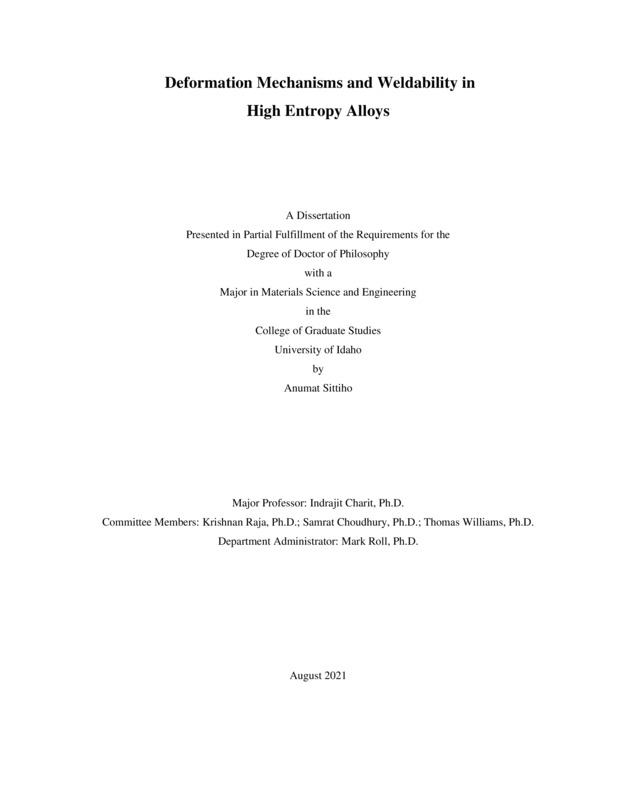Deformation Mechanisms and Weldability in High Entropy Alloys
Sittiho, Anumat. (2021-08). Deformation Mechanisms and Weldability in High Entropy Alloys. Theses and Dissertations Collection, University of Idaho Library Digital Collections. https://www.lib.uidaho.edu/digital/etd/items/sittiho_idaho_0089e_12155.html
- Title:
- Deformation Mechanisms and Weldability in High Entropy Alloys
- Author:
- Sittiho, Anumat
- ORCID:
- 0000-0003-3999-7525
- Date:
- 2021-08
- Embargo Remove Date:
- 2023-09-01
- Program:
- Materials Science
- Subject Category:
- Materials Science
- Abstract:
-
High entropy alloys (HEAs) are an emerging type of metallic materials which are generally comprised of five or more fundamental elements. Because of the influence of configurational entropy, HEAs exhibit simple single phase which is beneficial in alloy design and applications. For structural application, HEAs show an interesting combination between strength and ductility compared to conventional alloys because of twinning induced plasticity (TWIP) and transformation induced plasticity (TRIP). Selected HEA alloys, Al0.4CoCrFeNi and Fe42Mn28Cr10Cr15Si5, with TWIP and TRIP characteristics, respectively, are used in this study. The characteristic of transformative HEA and its weldability are studied through TRIP HEA by using friction stir welding/processing (FSP/W) and pressure resistance welding techniques. The FSP of TRIP HEA is done using a tungsten rhenium tool with the parameters of rotational speed of 300 rpm, traverse speed of 25.4 mm/min, and forging force of 30 kN. The FSPed specimen then was examined for its mechanical properties and microstructural relationship compared to the base metal specimen. The microstructural study is performed through the optical microscope, x-ray diffraction, transmission electron microscope, and scanning electron microscope. Mechanical properties of both specimens are tests using Vickers microhardness for mapping the weld cross-section and uniaxial compression for revealing the flow behavior of the specimens. The TRIP HEA displays good weldability when using the FSW technique. The microstructure undergoes dynamic recrystallization followed by gamma to epsilon phase transformation during FSP. The superior strength of the FSPed specimen compared to the base metal is the result of different martensitic transformation behavior as elucidated by the microstructural observation. Pressure resistance welding (PRW) is applied to conduct PRW weldability of the TRIP HEA. The weld parameters are varied to prototype the welding parameter on this type of material. The microstructural analysis by means of optical microscopy and scanning electron microscopy is conducted to evaluate the quality of the weld in the TRIP HEA. The finite element analysis using the electro-thermo-structural analysis model is created for visualizing the heat generation and material behavior during the PRW process. Mechanical properties in both macro and micro scales of TWIP HEA are studied through bulk compression testing and micropillar testing. The relationship between micro and macro scale is compared. Phase transformation characterization is done by using optical metallography, X-ray diffraction, and electron microscopy methods. The results reveal the dislocation dynamics during the deformation enhance the strain hardening in the alloys by forming dislocation microbands that initiate from the formation of Lomer-Cotrell lock dislocation. Thermal stabilities of the TWP HEA involving second phase precipitation, high temperature flow behavior, and thermal expansion are studied by using Vickers microhardness, high temperature uniaxial compression testing, and dilatometer. The B2 phase precipitation kinetics can be explained by using JMA model (Avrami’s kinetic). The flow curves at 600oC display serration flow which can be the effect of dynamic strain aging. The alloy shows no strain rate sensitivity in the homogenized specimen but small inverse strain rate sensitivity in the as cast specimen. Thermal expansion of this alloy is slightly higher than conventional alloy.
- Description:
- doctoral, Ph.D., Materials Science -- University of Idaho - College of Graduate Studies, 2021-08
- Major Professor:
- Charit, Indrajit
- Committee:
- Raja, Krishnan; Choudhury, Samrat; Williams, Thomas
- Defense Date:
- 2021-08
- Identifier:
- Sittiho_idaho_0089E_12155
- Type:
- Text
- Format Original:
- Format:
- application/pdf
- Rights:
- In Copyright - Educational Use Permitted. For more information, please contact University of Idaho Library Special Collections and Archives Department at libspec@uidaho.edu.
- Standardized Rights:
- http://rightsstatements.org/vocab/InC-EDU/1.0/

